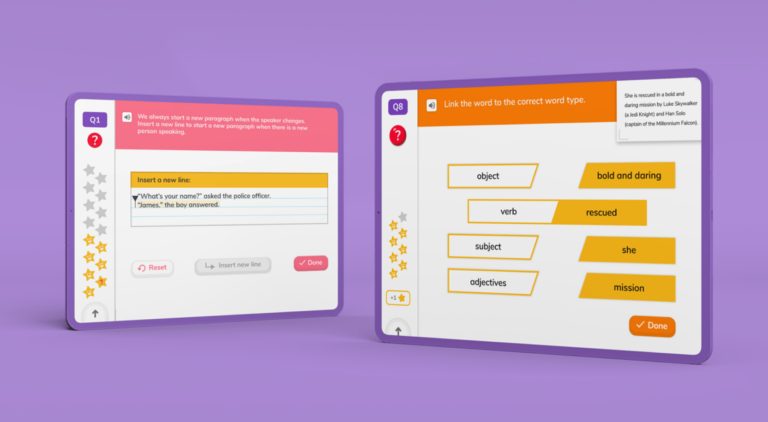

Get your hands on the building blocks of language

Author
Christina Levandowski
Published
March 2024


Get your hands on the building blocks of language

Author
Christina Levandowski
Published
March 2024


Get your hands on the building blocks of language

Author
Christina Levandowski
Published
March 2024


Key takeaways
Table of contents
Language can be an intimidating thing to learn about. It has so many ins and outs, rules and guidelines, and tricky applications that can be confusing if you don’t know the rules. However, even the most complex language can be understood once you strip it down to the basics. That’s where parts of speech come into play.
Parts of speech refer to the specific grammatical roles every single word in a sentence has. Think of these roles as jobs. For a sentence to be complete and understandable, some jobs are vital while other jobs make the sentence deeper and more complex. To learn how a language works, you have to start with these parts of speech.
As you learn what they are and how they work with other parts of speech, you’ll soon pick up on the patterns and rules that govern the way language functions.
Nouns are words that identify persons, places, things, and ideas. “Horse”, “London”, “cranberries” and “courage” are all examples of nouns. Nouns also come in many different varieties.
For example, you can have singular or plural nouns. Singular nouns are words that identify a single thing, like “dog”. Plural nouns take that thing and indicate that there are more than one. Usually, this just means adding an “s” or “es” to the end of the noun. “Dog” becomes “dogs” when you are referring to more than one.
There are exceptions when the spelling of the singular noun would make adding an “s” to the end clunky. For instance, the word “knife” is singular, but “knifes” as the plural sounds odd. To make that noun plural, you change the word to “knives” for a smoother pronunciation.
Another important noun pairing is the common noun vs. the proper noun. Common nouns refer to nonspecific things whereas proper nouns identify specific things. “Person” is a common noun because you could use that word to identify anyone, but a name like “Billie” is proper because you would use the word only for a specific person named Billie. For this reason, proper nouns are always capitalised.
Pronouns are a specific set of words that can replace nouns in a sentence. Writers do this to avoid repetition of the same nouns over and over again, but pronouns can be as tricky as they are helpful. The most common pronouns are words like “I”, “him”, “her”, “it”, “we”, “they” and so on. When writing, however, be wary of using pronouns too much as they can sometimes make determining exactly who or what you are talking about unclear.
Pronouns, like nouns, come in many shapes and sizes. The most common are personal pronouns like “I”, “me”, “you”, “he”, “her” and so on. These replace nouns and pronouns that refer to people, hence the “personal” part of the title. Possessive pronouns like “my”, “yours”, “his” and “hers” are used when identifying ownership of something, and these are fairly common as well.
Verbs detail the actions that take place in a sentence. These can be very obvious actions like “kick”, “jump”, “yell” and “fly”, but they can also be more subdued like state-of-being verbs such as “am”, “was” and “is”. Every sentence needs to have at least one verb, so they are very important.
Verbs can also be a bit confusing, too. The way you write out a verb depends on the noun that it is connected to, the noun performing said action. Verbs also change based on tense or the “when” of the sentence. Present tense verbs like “runs” or “talks” indicate an action occurring right now whereas past tense verbs, typically ending in -ed, indicate a past action like “jumped” or “tackled”.
The process of changing the way a verb is written to reflect the thing doing the action is called conjugation. Some verbs are special, though, and follow unique rules for how you change them based on tense and related nouns.
Verbs have plenty of variety, too. Specifically, you’ll want to know about transitive, intransitive, and state-of-being verbs. Transitive verbs are verbs that have an “object” in the sentence being affected by the verb. The verb “tossed” in the sentence “Susan tossed the ball” is a transitive verb because the “ball” is an “object”. The ball is receiving the action of being thrown.
Intransitive verbs are actions without an object. The verb “feel” in the sentence “I feel pretty” does not have an object. However, if you have “I feel the rain,” now “rain” is an object, making “feel” transitive in that case. As you can see, verbs can change a lot based on how you use them.
Verbs can also cover “state of being,” which refers to words that indicate that things simply are. All forms of the verb “to be” are state-of-being verbs. For example, “I am tired” has the verb “am” establishing the state or status of “I” which makes it a verb. People often forget that all forms of the verb “to be” are verbs, so keep your eyes on that one.
Things begin to get a little simpler with adjectives. These words modify or describe nouns and pronouns. When you want to reveal a little more about a noun like its colour or how big it is, you use an adjective. The “blue” house or the “gigantic” tree are both examples of adjectives.
Just as adjectives modify nouns, adverbs modify verbs. These words, which typically end in -ly, indicate the extent and intensity of an action. He ran “quickly” or they talked “endlessly” both demonstrate that adverbs paint a better picture of exactly how the action was done in a sentence.
Prepositions can take some people a moment to grasp, but a hint at their function is right there in the name. A preposition indicates positioning or how different elements in a sentence relate to one another in space and time. Another classic way to remember what words count as prepositions is to think about the words you would use to describe the position of a bird relative to a cloud.
The bird can be “in”, “under”, “around”, “through” the cloud and so on. These are all prepositions, and this thought experiment will catch most of them. The only other preposition to remember is “of” which doesn’t always work with the bird and cloud trick.
The name of the part of speech here also hints at its function. Conjunctions form a “junction” between parts of a sentence. In other words, they connect pieces of a sentence. Words like “and” or “or” can join nouns and even entire clauses together while subordinating conjunctions like “when” or “because” link dependent clauses to independent clauses. In short, if the word is joining things grammatically in a sentence, it is probably a conjunction.
Interjections are simple and fun. These words do not serve a real grammatical purpose in the sentence. Rather they are bonus words often added in for emphasis or emotional expression. For example, “Wow, grammar is complex!” The word “wow” doesn’t provide any new information. Instead, as an interjection, “wow” conveys the narrator’s surprise. These words are set off from the rest of the sentence with commas to signal that they are not providing new information.
A determiner is a word that introduces a noun, and you will always place it before the noun in a sentence. These often-overlooked words serve important roles in English grammar. They can indicate whether you’re referring to a specific item or not with “the” as compared to “a”. Some also work as demonstratives indicating which specific thing someone is talking about with words like “this” or “that”.
Unlock unlimited English questions
Put your skills to the test with fun exercises + learning games that are proven to boost ability!
DoodleEnglish is an app that’s filled with thousands of fun, interactive exercises covering grammar, punctuation, spelling and more!
Designed by teachers, it creates each child a unique work programme tailored to their needs, boosting their confidence and skills in English. Try it for free today!

When constructing sentences in English, there are certain grammatical rules you need to follow to ensure that the sentences read well and make sense. Parts of speech are vital to understanding these rules for both clarity and creativity.
English syntax can get very convoluted, but there are a few key things to keep in mind when applying parts of speech to sentence construction.
At first glance, understanding parts of speech might seem easy, but given how flexible English can be, this task can be much more challenging than you might expect. Here are some of the more common pitfalls.
This all just scratches the surface of what parts of speech entail in English, but understanding these basics is an important step toward grasping the more complex layers of the language.
Many words can function as different parts of speech. You need to look at the function of a word to figure out what part of speech it is.
Just like understanding the parts of an engine will make you a better mechanic, understanding parts of speech will make you a better writer. You need to know the foundational rules and terms for the more involved aspects of English to make sense.
Many online learning sites offer interactive games and practices to help you learn the parts of speech. You can also try taking words and using them as different parts of speech to gain a better appreciation for how flexible the language can be.
Book a chat with our team
If you’d like to use Doodle’s browser version, please visit this page on a desktop.
To log in to Doodle on this device, you can do so through our apps. You can find out how to download them here: